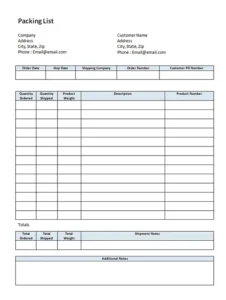What is an Import Packing List?

Components and Details Included in an Import Packing List
An import packing typically includes the following components and details:
- Product Information: This section provides details about the items in the shipment, including their names, descriptions, and any relevant identifiers like SKU (Stock Keeping Unit) numbers or classification codes.
- Quantity and Unit of Measure: It specifies how many units or pieces of each product are included in the shipment and the unit of measure used, such as pieces, boxes, or kilograms.
- Weight and Dimensions: This includes the weight and size of each product and the total weight and dimensions of the entire shipment. This information is crucial for storage and transportation planning.
- Packaging Details: This section describes how the goods are packed, including the types of packaging used (e.g., cartons, crates, pallets), the number of packages, their dimensions, and any special instructions for handling the shipment.
- Shipping Marks and Numbers: This includes any markings, labels, or identification numbers on the packages, which help with tracking and identifying the goods during transit.
What is an Export Packing List?
Components and Details Included in an Export List
An export list typically includes the following components and details:
- Product Information: This section provides details about the items being exported, including their names, descriptions, SKU numbers, and any relevant codes or classifications.
- Quantity and Unit of Measure: Specifies the number of units or pieces of each item being exported and the unit of measure used, such as pieces, boxes, or kilograms.
- Weight and Dimensions: Lists the weight and dimensions of each item as well as the total weight and dimensions of the shipment. This helps in planning the logistics for transportation and storage.
- Packaging Details: Describes how the goods are packed, including the types of packaging used (e.g., cartons, crates, pallets), the number of packages, and their dimensions. It may also include special handling instructions.
- Shipping Marks and Numbers: Includes any shipping marks, labels, or identification numbers placed on the packages to help with tracking and identifying the goods during the export process.
- Country of Origin: Specifies where the goods were made or produced, which is important for customs and regulatory purposes.
- Exporter’s Details: This includes the name, address, and contact information of the exporter, which may be required for export documentation and customs processing.
- Destination Information: Includes the destination country, the name of the consignee, and the delivery address, providing essential information for shipment routing and customs clearance.
Key Differences between Import and Export Packing Lists
While import and export lists share similar purposes and components, there are some key differences to note:
| Aspect | Import Packing List | Export Packing List |
| Purpose | Helps customs verify goods and calculate duties/taxes for incoming shipments. | Helps customs verify goods and ensures compliance for outgoing shipments. |
| Destination of Goods | Focuses on goods coming into the country. | Focuses on goods leaving the country. |
| Customs Role | Assists customs in the country receiving the goods. | Assists customs in the destination country. |
| Information on Origin | Does not usually include the country of origin. | Includes the country of origin for customs purposes. |
| Exporter and Consignee Details | May not include the exporter’s details. | Includes exporter’s details and consignee’s information. |
| Shipping Marks and Numbers | Used for identification and tracking within the country of import. | Used for identification and tracking during the export process. |
| Customs Documentation | Used by customs in the importing country to verify arrival and classification of goods. | Used by customs in the exporting country to ensure proper documentation for export. |
Importance of a Packing List in Import and Export
The packing inventory is essential in both import and export processes. It helps ensure customs clearance by providing detailed information for verifying goods, classifying them correctly, and calculating duties and taxes. It aids in efficient handling and storage, helping staff manage goods based on size, weight, and packaging. By accurately listing items, it reduces risks and disputes, preventing errors or delays. The packing list also allows easier tracking and identification during transit. It ensures compliance with regulations, avoids legal issues, and plays a key role in accurate billing and recordkeeping, ensuring correct duties and taxes are paid.

